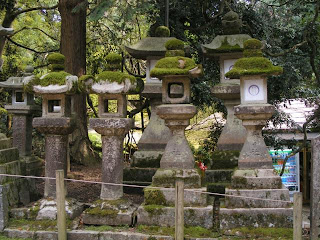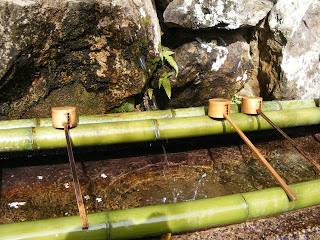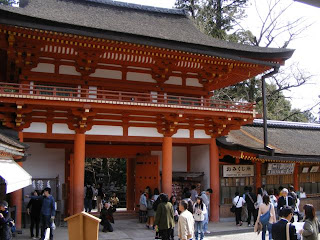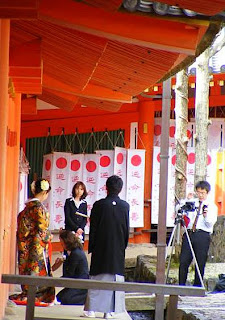What are toros? These are lanterns, made of stone or bronze, widespread in Japan more than in China or Korea. At the beginning they have been used in the Budhist temples to illuminate the alleys, hence the name of “light baskets”. During the Heian period they have been introduced in the Shintoist shrines, and to the end of the XVIth. Century they begun to be used to adorn the gardens. The toro can be hanging toro – tsuri-doro – or platform type – dai-doro.
The alley to the shrine is bordered by over 1000 stone lanterns. At the entrance, the purification fountain is watched over by a huge deer. As soon as you enter the shrine grounds, you see the hanging bronze lanterns. Offerings to the deities, they are lit twice a year on 3rd. February and 14-15 August. Kasuga-taisha is protected by UNESCO.
If you are lucky, you may see at the Shinto shrines newly wed couples, praying and taking photos. What better final for my post?
La cca. 20 de minute de plimbare de Todai-ji se afla altarul shintoist Kasuga-taisha. Inca de la primele fotografii vazute pe internet, m-a impresionat multimea de lanterne de toate felurile si am considerat locul de un estetism deosebit. Undeva am citit ca ceea ce este altarul Fushimi Inari pentru torii, Kasuga-taisha este pentru lanterne si cred ca nu a gresit cine a spus asta. Peste 1000 de felinare din piatra marginesc aleea care urca spre altar, iar in interior te intampina o multime de felinare din bronz. De altfel, altarul face parte dintre Monumentele Istorice ale Narei Antice, de sub patronajul UNESCO.
Felinarele, toro, sunt mult mai mult prezente in Japonia decat in China sau Coreea. Ele pot si din piatra sau bronz. Initial s-au folosit doar in templele budhiste, pentru a ilumina aleile, de unde si denumirea de “cos de lumina”. Treptat, au inceput sa fie considerate o ofranda care se poate aduce zeilor. Abia in timpul perioadei Heian (794-118) au fost introduse si in altarele shintoiste, iar la sfarsitul secolului al XVI-lea, maestrii ceremoniei ceaiului au inceput sa impodobeasca cu ele gradinile, asezandu-le langa apa sau constructii. Astfel, ele au devenit unul dintre elementele importante ale gradinii clasice japoneze. Felinarele sunt de doua feluri: cele de tip platforma, dai-doro si cele care atarna, tsuri-doro.
Kasuga-taisha este altarul puternicului clan Fujiwara, foarte influent in Japonia in epocile Nara si Heian. A fost construit in anul 768. La intrare, remarc nelipsitul torii si fantana de purificare, strajuita aici de un cerb puternic. A te purifica inainte de a te adresa zeilor este un act obligatoriu (Misogi). Actiunea in sine de a te spala pe maini si pe gura se numeste Temizu, iar ceremonialul poarta numele de Harai.
De indata ce treci de poarta de intrare (gratuit, ca la toate altarele shinto), privirea iti este atrasa de multimea de felinare din bronz. Acestea sunt aprinse de doua ori pe an: la inceputul primaverii, in 3 februarie si in 14-15 augus
Cum se intampla de multe ori la altarele shintoiste, poti avea noroc sa vezi niste miri veniti sa aduca ofranda zeilor si sa faca fotografii. Iata perechea pe care am vazut-o noi: mai intai am aruncat o privire cam indiscreta in locul in care se faceau fotografiile, vazand cum mirele asista la pregatirea faldurilor kimonoului miresei; apoi, cand au plecat de acolo, au trecut chiar pe langa noi si ne-au pozat fericiti, din mers. Ce final mai bun as putea avea pentru acesta postare?


























Wow!, the pictures are beautiful, so full of colors.It is amazing to see so many lanterns, and newly weds look great too.
You have taken us to Japan and showed us some incredible things that usually we are not aware of : the road less travelled..
I have very good memories of this place. We were impressed.
Greetings,
Filip
I missed so many posts lately, I hope I’ll have the time to catch up!
Welcome back, VP! Take it easy, you have time.
Wonderful photos!
I remember the day.
Toros are too ordinary,too boring things for us Japanese,but this kind of lantern is never seen in Europe,I think.It seems that you have fresh impression toward toros.
It is interesting.
Well, not this type of toro, anyway. But in countries with Arabic influences, like Spain, you may see lanterns of other types, Kumiko. What is astonishing at Kasuga-taisha is the quantity.
Foarte frumos.
Imi imaginez ce priveliste e atunci cand aceste felinare sunt aprinse. Trbuie sa fii norocos sa prinzi acele zile din an in care se aprind.
Inca o data trebuie sa te laud pentru fotografiile facute :))
Multumesc pentru laude, Cartim:)
Ca sa vezi lanternele aprinse trebuie sa fii informat, nu norocos:)
rama, thank you so much for your nice words!
It IS impressive, Filip. Thanks for the visit!
The deer is adorable, the moss on the stone lanterns beautiful, and the kimono of the bride stunning!
You underlined the nicest things, Helma! Thanks!
I’m glad you also explain what those toros are so 🙂 The lanterns of stone or bronze. I think they still look good too 🙂 They were therefore first used for streets and later only for gardens.
Very nice blog again with very nice pictures.
Again and again benefit here.
Warmest regards, Helma
Thank you for your opinion, Helma! The toro have been used firstly in temples.
Wow, super! Trebuie sa ajung si eu aici, templul asta nu l-am vazut. Caprioara din a doua poza era adevarata sau doar o statuie? Pare reala in poza.
Cat despre nunti, multe cupluri nu se mai imbraca in costume traditionale la nunta, deh curentele noi sunt mai interesante…
Da, era adevarata, Ami! Se plimbau in voie printre oameni.
Am avut noroc sa vad cuplul acela. Kimonoul e frumos si amandoi sunt draguti. Au vazut ca ii fotografiez si s-au oprit o clipa, indreptandu-se cu fata spre mine si zambind pentru poza.
De n-ai fi explicat ce e, aş fi spus că e un cimitir. Ce înseamnă să nu ştii despre ce e vorba!
E un loc impresionant, Liliana!